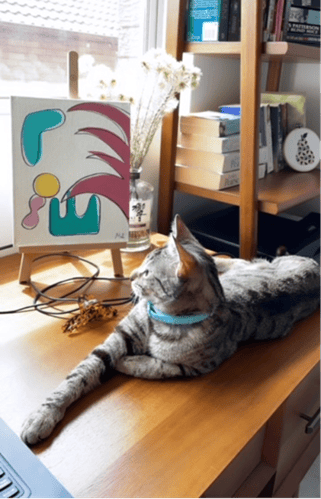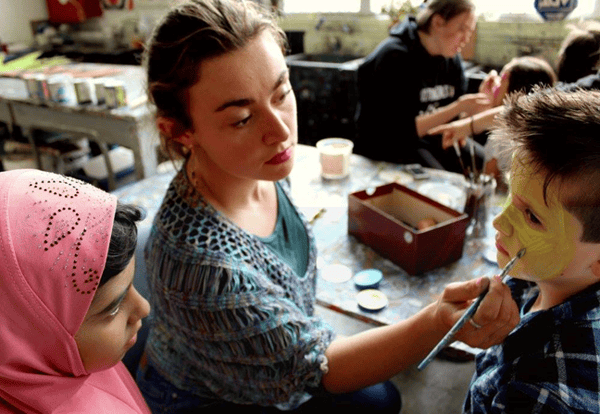Welcome to your MCI Wellbeing Blog for February!
This month we are talking about Creative Outlets!
What are creative outlets?
When it comes to creativity, we all enjoy it in some way, shape or form. Whether this involves doodling in a notepad, cooking a new recipe, dressing to express, or simply taking the time to acknowledge our surroundings without modern day distractions, creativity is a vital part of the human experience and has greatly influenced our evolution since we started drawing whacky figures on cave walls 40,000 years ago.
No matter how we choose to embrace the right-hand side of our brain, it’s clear that creative outlets boost our mood and improve our quality of life. But what does science have to say about the benefits of creativity?
-
What the studies say:
Science confirms what we already know-creative outlets are good for us. Research has shown that partaking in creative outlets creates stronger social relationships, reduces stress, and allows us to develop a deeper appreciation for the world around us. Creative outlets can play an important part in acknowledging deep-seated emotions and experiences, giving them a tangible existence, and making them easier to process.
-
 Gavin Clayton, executive director of leading mental health and arts charity Arts and Minds, is a strong advocate for the important role creative outlets have in well-being. ‘The arts are important for well-being because beauty has a role in our lives’ Clayton states, ‘If we don’t listen to that, or pay attention, then that can cause problems’.
Gavin Clayton, executive director of leading mental health and arts charity Arts and Minds, is a strong advocate for the important role creative outlets have in well-being. ‘The arts are important for well-being because beauty has a role in our lives’ Clayton states, ‘If we don’t listen to that, or pay attention, then that can cause problems’.Clayton’s organisation studied participants experiencing stress, depression, and anxiety who partook in activities such as sculpture, oil painting, and print making over a 7-year period. This study revealed a 71% decrease in feelings of anxiety and a 73% fall in depression. Around 76% of participants said their well-being increased and 69% felt more socially included. One participant of the programme said: ‘I feel so much better having had the time and space to do some art. It makes such a difference.’
-
An everyday artist’s perspective:
When we think of an artist, we often conjure up images of significant figures such as Leonardo Da Vinci composing the Mona Lina or Picasso crafting masterpiece after masterpiece. Although both Da Vinci and Picasso are undoubtedly some of the most accomplished artists of all time, we often overlook the artistic potential within ourselves and those around us. Everyone can harness their artistic side, whether that’s through a hobby or career path.
Nina McDonald, stage set designer and builder, explains how getting into illustration was beneficial for her mental health. ‘It’s like meditation -you end up looking at details with a magnifying glass and gain a deeper sense of perspective. It’s a way to value and respect everyday objects-things that people would normally step over, such as a plant, shell or feather.’
English major graduate Freya Gardener believes that writing is a great way to develop compassion towards others: ‘I think writing is a really powerful tool for empathy. It can give you that simulated experience of being someone else, who maybe hasn't had the positive experiences you have or who is in a completely different life circumstance to you’.
High school English and Classics teacher Katrina Stevenson does crotchet to find a deeper connection with herself and those around her: ‘Crochet is one of the few things I have outside of my paid (teaching) and unpaid jobs (mumming!) that’s just for me! It reminds me that I’m a human being who has her own interests, and it’s the kind of hobby you can pick up and put down, so I can fit it in around everything else’.
.png?width=600&name=The%20Positive%20Impact%20of%20Creative%20Outlets%20(1).png)
-
Bachelor of Science student Sophie Willis uses the ukulele as her creative outlet: ‘It’s gives me time to de stress and spend quality time with myself. I can sit and strum for a few minutes or a few hours if I get into a groove! Music brings me so much joy and the act of creating different sounds with my hands is so soothing to me.’
SPCA Volunteer Coordinator and dog trainer Sarah Endres sums up creative outlets in the following quote: ‘It creates an escape from the realities we have, creates the endorphins we do absolutely need and crave now, and just create an alternative, exciting pathway for goal setting and achievement’.
It’s important to recognise that everyday artists, the neighbours, the co-workers, the teachers, have the potential to implement profound change, not only in themselves but the world around them, through pursuing their creative outlets.
-
How to embrace your creative side:You don’t need to be able to write a symphony like Mozart or paint like Picasso to embrace your creative side! Creativity comes in many shapes, sizes and forms and everyone can engage in creative pursuits and processes. It doesn’t need to be as narrow as the arts, though the arts are a great outlet for developing your artistic flair. Your version of creativity may look completely different to someone else’s, and there are many ways it can be fostered or nurtured. Consider some of the following ideas:
-
- Everyday creativity
Problem-solving in the day-to-day, whether it be in your personal life or at work, is another way you can practice creativity or thinking divergently. Think about concepts such as framing a problem as a question, looking at things from another perspective, brainstorming various ideas and solutions with others, or having a “yes and” mentality to things. These are all ways you can tackle problems or challenges in new and effective ways. .png?width=480&name=The%20Positive%20Impact%20of%20Creative%20Outlets%20(4).png)
- - Spend time in nature
Being away from the hustle and bustle of the everyday as well as technology can help get those creative thought flowing. It means less multi-tasking or trying to keep up with goals or actions and more focus on the present moment and enjoying all the positive stimuli around you in nature.
What beautiful natural surroundings do you have nearby? Possibly a local park or national park to go walk-abouts or hiking in?
- - Play
Play isn’t just for kids! Adults can also reap several emotional and psychological benefits by taking part in activities such as using your imagination in art, storytelling, and interactive games, not to mention it being loads of fun. It allows for expression, problem-solving, self-confidence and joy. Why not try a board-game, escape room, storytelling word-game or joining a local sports team?
- Search for inspiration
Take the opportunity to look for aesthetically pleasing outlets or surrounds near you to help stimulate down-time and ease the mind-traffic we are often bombarded with day-to-day. You could sit in a beautiful park on a lunch break, visit an art gallery, read a novel, look at some art or photography online. The options are endless! You never know the inspirational and spontaneous thoughts you may have.-
.png?width=480&name=The%20Positive%20Impact%20of%20Creative%20Outlets%20(3).png)
- -Draw or paint
Activities such as drawing and painting have been proven to relieve stress and depression and improve memory and resilience. It can be as simple as putting pencil to paper or purchasing some water colours, some adult colouring books and getting stuck into it without pressure or expectation, no matter your experience or expertise level. Just buy some art supplies and give it a go.
For a more structured instructor-led activity, there are also a lot of “paint and sip” classes popping up that you can sign up for.- - Wake and write
Put some pen to paper or that keyboard to work by spending some time in the morning (or afternoon – there are no rules), free writing with no censoring and no limitations. Let the ideas flow as they may, and you may be surprised by the results. You could put some relaxing music on in the background and even set a time limit or page limit for yourself. You may like to use writing prompts or questions to focus your thoughts, such as “what would you tell your 14-year-old self?”, or just see what comes up naturally and organically for you. You don’t even need to share it with anyone or keep it.
How the mentor’s practice creativity:
- Mila:
Walking by water and trees completely relaxes me, sunrise, day time and sunset. Harbour, river, lake or beach not fussed. One of my favourite walks involves several local parks on the harbour. I walk this twice daily with my gorgeous toy poodle.
I come up with plenty of ideas and resolutions while I watch the view.

- Melike:
Research, research, research! Whether it’s a quick Google search for something I am studying or a new strategy to try at work, I always look online for inspiration to get the ideas flowing.
Rest – recognising when I’m feeling tired and allowing myself the time to recharge. - New experiences – I love trying new things at least once to see what I really enjoy and to push myself outside my comfort zone.
- Dabbling in new hobbies I can do at home any time- knitting, embroidery, painting, drawing, listening to different music genres, whatever I feel like at the time.

- Julia:
Some of my favourite creative outlets are included in my morning routine-I won’t get up any time before 9am without some music to get me going! I also love to write journal entries with my morning cup of coffee. Creativity outlets for me include art museums, live music, painting, writing, DJ classes, and leafing through cookbooks in an attempt to become the next Jamie Oliver. And earrings. Lots of funky earrings.
.png?width=113&name=MCIinstitute_RGB_Color_Black-01%20(2).png)



